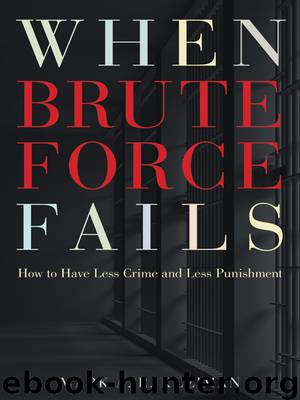When Brute Force Fails by Kleiman Mark A. R

Author:Kleiman, Mark A. R. [Kleiman, Mark A. R.]
Language: eng
Format: epub
ISBN: 978-1-4008-3126-5
Publisher: Princeton University Press
Published: 2009-03-25T16:00:00+00:00
SKETCH OF A COST-BENEFIT ANALYSIS
How do the three main categories of criminal-justice expenditure—on policing, on incarceration, and on community corrections—stack up against one another as ways of spending public dollars to reduce crime? Any attempt to answer that question must necessarily elide the differences within each of those categories; some police activities are more useful than others, some prisoners more worth confining than others, some probation programs more successful than others. Still, though the aggregate numbers do not tell us everything, they can tell us something.
John Donohue,* summarizing and re-analyzing a large literature, estimates26 that the elasticity of crime to incarceration is about -0.2: that is, a 10 percent increase in incarceration would be expected to lead to about a 2 percent reduction in crime. That estimate is closer to the top than the bottom of the range of figures reported by Steven Leavitt† and Thomas J. Miles.27 Both reviews cite the work of William Spelman,* who gives a range of between -0.2 and -0.4.28 If the true number were in this range, and restricting our attention to the costs and benefits to taxpayers and actual and potential crime victims while ignoring the costs to offenders, the gain would exceed the cost. If the total cost of crime is something like $1 trillion per year, the value of a 2 percent reduction is $20 billion per year, while a 10 percent increase in the $50 billion incarceration budget would cost only $5 billion. Thus the argument that we “can’t afford” to build more prisons seems dubious.
But there are reasons to think the actual effect of incarceration on crime might be smaller. The prison population has grown even as the crime rate has fallen, implying that today’s prisoners are less criminally active when not in prison than were prisoners at the time when most of the empirical work on the topic was performed. And, assuming that the criminal-justice system does some sorting by personal crime rate in making incarceration decisions, further expansion is likely to come among offenders still less active than those already behind bars: the average offender in prison has ten to fifty times the personal crime rate of the average offender not in prison.29 If instead greater incarceration were achieved by handing out longer sentences, that would push up the age distribution of prisoners, and thus push down the average number of crimes prevented per prisoner-year.
In terms of deterrence, Nagin suggests that “time served in prison reduces responsiveness to future punishment.”30 If so, current incarceration makes future incarceration less effective. Further expanding incarceration would also be expected to reduce the stigma associated with having been to prison31 and thus the incentive for those who have never been imprisoned to avoid that first prison term. These arguments provide theoretical support for recent statistical evidence that as incarceration grows, its effect on crime falls.32 Bert Useem and Anne Morrison Piehl* calculate that a 10 percent increase in incarceration from current levels would likely bring a reduction in crime of only
Download
This site does not store any files on its server. We only index and link to content provided by other sites. Please contact the content providers to delete copyright contents if any and email us, we'll remove relevant links or contents immediately.
The Borden Murders by Sarah Miller(4275)
The Secret Barrister by The Secret Barrister(3661)
Police Exams Prep 2018-2019 by Kaplan Test Prep(2516)
Coroner's Journal by Louis Cataldie(2458)
The Splendid and the Vile by Erik Larson(2415)
Terrorist Cop by Mordecai Dzikansky & ROBERT SLATER(2051)
My Dark Places by James Ellroy(1910)
A Colony in a Nation by Chris Hayes(1901)
The Art of Flight by unknow(1840)
Black Klansman by Ron Stallworth(1766)
Objection! by Nancy Grace(1762)
A Life of Crime by Harry Ognall(1710)
The New Jim Crow by Michelle Alexander(1675)
American Prison by Shane Bauer(1642)
Anatomy of Injustice by Raymond Bonner(1640)
Invisible Women by Caroline Criado Perez;(1605)
Whoever Fights Monsters by Robert K. Ressler(1592)
Obsession (The Volkov Mafia Series Book 1) by S.E Foster(1557)
A is for Arsenic: The Poisons of Agatha Christie (Bloomsbury Sigma) by Kathryn Harkup(1525)
